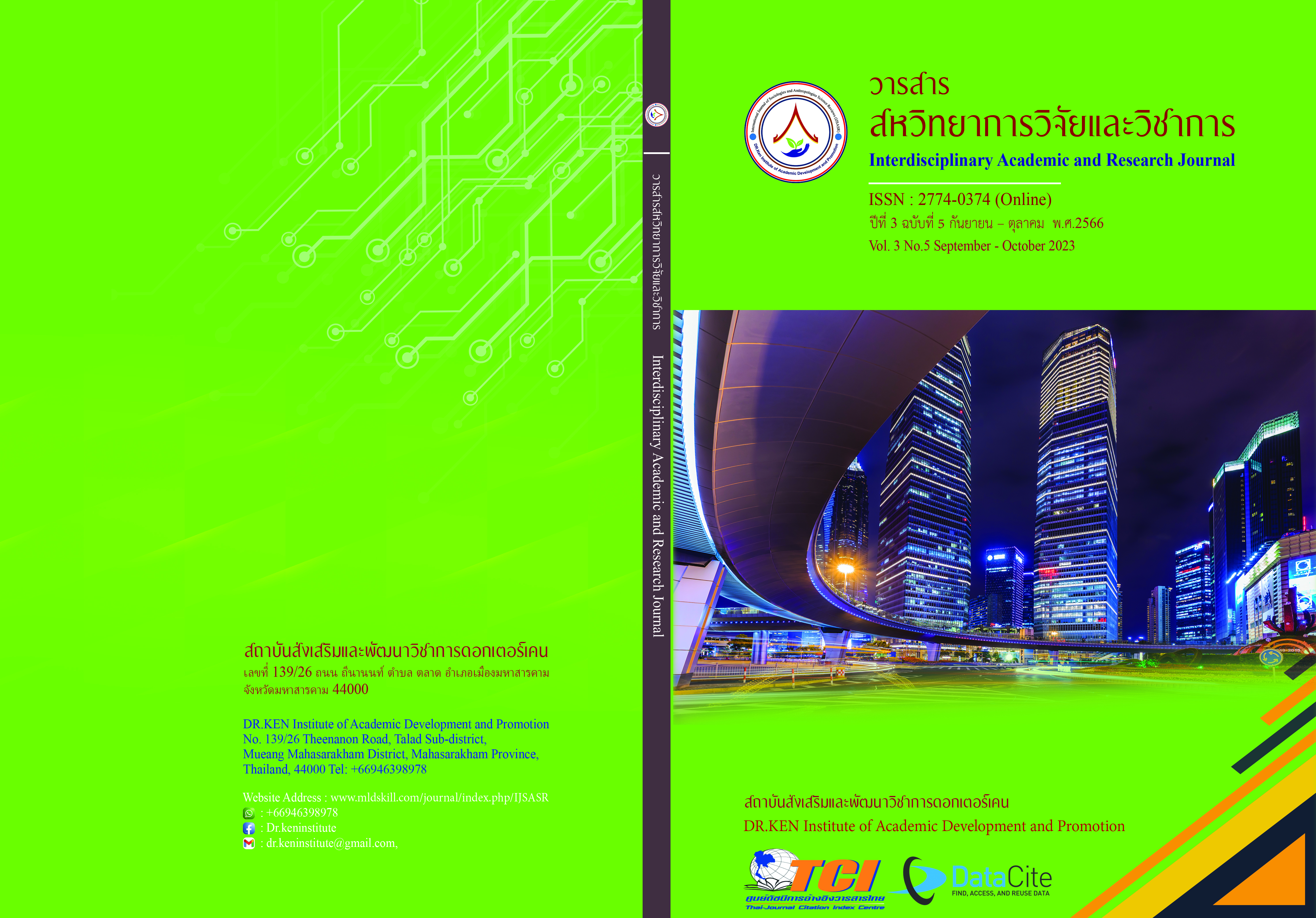A Study of Conceptual Change on Chemical Bonding and Scientific Attitudes of Grade 10 Students
DOI:
https://doi.org/10.14456/iarj.2023.251Keywords:
Science Conceptual Change; , Chemical Bonding; , Scientific AttitudeAbstract
Chemistry is a branch of science, that is important for learning in science, and found that many students have trended alternative conceptions and increased misconceptions. This research study was action research in 3 operational cycles. The research objectives were to study the conceptual change in chemical bonding and the scientific attitude of grade 10 students who have learned through conceptual change strategies. The research target group consisted of twenty-six grade 10 students at Borabuwittayakhan School in the first semester of the 2022 school year. The research instruments included 1) the 9 lesson plans using conceptual change strategies on chemical bonding for grade 10 students for 13 hours, 2) a two–tiers multiple choices chemical bonding concept test of 13 items with difficulties between 0.40–0.70, discrimination between 0.40–0.80 and reliability as 0.84 and 3) a five rating scales scientific attitude test in 6 aspects included Rationality, Curiosity, Open-mindedness, Honesty and Objectivity, Perseverance, and Suspended Judgment for 30 items with discrimination power between 0.42–0.89 and reliability of 0.73. The data analysis statistics included mean, standard deviation, and percentage. The study found that grade 10 students regularly increased their level of science conceptual understanding in each operational cycle. The first operational cycle found that 34.61 percent of the students passed the Partial Understanding criteria and 65.39 percent of the students failed the criteria. The second operational cycle found that 53.84 percent of the students passed the Partial Understanding criteria, which increased from the first operational cycle to 19.23 percent and 46.16 percent of the students failed the criteria, which decreased from the first operational cycle to 19.23 percent. The third operational cycle found that 73.08 percent of the students passed the Partial Understanding criteria, which increased from the second operational cycle of 19.24 percent and 26.92 percent of the students failed the criteria, which decreased from the second operational cycle of 19.24 percent. Students’ scientific attitude in all aspects was at a high level.
References
กระทรวงศึกษาธิการ. (2551). หลักสูตรแกนกลางการศึกษาขั้นพื้นฐาน พุทธศักราช 2551. กรุงเทพฯ: โรงพิมพ์คุรุสภาลาดพร้าว.
ณัชธฤต เกื้อทาน. (2557). การพัฒนาแบบจำลองความคิดเรื่องพันธะเคมี ของนักเรียนชั้นมัธยมศึกษาปีที่ 4 ด้วยกิจกรรมการเรียนรู้โดยใช้แบบจำลองเป็นฐาน. วิทยานิพนธ์ปริญญามหาบัณฑิต: มหาวิทยาลัยเกษตรศาสตร์.
ทิศนา แขมมณี. (2559) ศาสตร์การสอน: องค์ความรู้การจัดกระบวนการเรียนรู้ที่มีประสิทธิภาพ. พิมพ์ครั้งที่ 20, กรุงเทพฯ: จุฬาลงกรณ์มหาวิทยาลัย.
ปวีณา งามชัด. (2556). การเปลี่ยนแปลงมโนมติทางวิทยาศาสตร์ และความสัมพันธ์ระหว่างการเห็นคุณค่าในตนเอง กับการเปลี่ยนแปลงมโนมติ เรื่องการสืบพันธุ์ของพืชดอก ของนักเรียนชั้นมัธยมศึกษาปีที่ 5 เมื่อใช้ยุทธศาสตร์การสอนเพื่อเปลี่ยนมโนมติ. วิทยานิพนธ์ปริญญามหาบัณฑิต: มหาวิทยาลัยขอนแก่น.
พรประสิทธิ์ ศรีสุวรรณ. (2553). การปรับเปลี่ยนมโนมติ เรื่องเซลล์ ของนักเรียนชั้นมัธยมศึกษาปีที่ 4 โดยใช้ยุทธศาสตร์การสอนเพื่อเปลี่ยนมโนมติตามแนวของ Hewson and Hewson (2003). วิทยานิพนธ์ปริญญามหาบัณฑิต: มหาวิทยาลัยขอนแก่น.
โรงเรียนบรบือวิทยาคาร. (2565). ข้อมูลสถิติจำนวนนักเรียนโรงเรียนบรบือวิทยาคาร. มหาสารคาม: โรงเรียนบรบือวิทยาคาร.
สถาบันส่งเสริมการสอนวิทยาศาสตร์และเทคโนโลยี. (2555). การวัดผลประเมินผลวิทยาศาสตร์. กรุงเทพฯ: ซีเอ็ดยูเคชั่น.
สมเจตน์ อุระศิลป์ และศักดิ์ศรี สุภาษร. (2554). การเปรียบเทียบมโนมติก่อนเรียน และหลังเรียน เรื่องพันธะเคมี ตามโมเดลการเรียนรู้ T5 แบบกระดาษ. วารสารวิจัยมหาวิทยาขอนแก่น, 1(1), 38–57.
สังวาล ดิรัตนวงษ์. (2562). การเปลี่ยนแปลงมโนมติทางวิทยาศาสตร์ เรื่องการดำรงชีวิตของพืช ของนักเรียนชั้นมัธยมศึกษาปีที่ 1 โดยใช้ยุทธศาสตร์การสอนเพื่อเปลี่ยนมโนมติของ Hewson & Hewson (2003) ร่วมกับการวัดและประเมินผลเพื่อพัฒนา. วิทยานิพนธ์ปริญญามหาบัณฑิต: มหาวิทยาลัยขอนแก่น.
สุนิษา คำสะอาด. (2557). การเปลี่ยนแปลงมโนมติทางวิทยาศาสตร์ เรื่องการสืบพันธุ์ของนักเรียนชั้นมัธยมศึกษาปีที่ 4 โดยใช้ยุทธศาสตร์การสอนเพื่อเปลี่ยนมโนมติตามแนวคิดของ Hewson and Hewson. วิทยานิพนธ์ปริญญามหาบัณฑิต: มหาวิทยาขอนแก่น.
เสาวนีย์ สังฆะขี และวรรณจรีย์ มังสิงห์. (2555). ความเข้าใจมโนมติทางวิทยาศาสตร์ เรื่องบรรยากาศ ของนักเรียนชั้นมัธยมศึกษาปีที่ 2 ภายหลังการใช้ยุทธศาสตร์การสอนเพื่อเปลี่ยนมโนมติของ Hewson & Hewson (2003). Journal of Education Graduate Studies Research, 6(2), 186–195.
อรรถพล พลอยมีค่า. (2563). แบบทดสอบวินิจฉัยสามลำดับขั้นเพื่อระบุมโนมติที่คลาดเคลื่อน เรื่องสมดุลเคมี. วารสารวิชาการและวิจัยสังคมศาสตร์. 15 (3), 105-118.
อัจฉรีรัตน์ ศิริ, ประนอม แซ่จึง และกานต์ตะรัตน์ วุฒิเสลา. (2558). การสำรวจมโนมติทางวิทยาศาสตร์ เรื่องสารโคเวเลนต์ และไอออนิก โดยใช้เทคนิคแบ่งลุ่มผลสัมฤทธิ์ร่วมกับบัตรแสดงพันธะเคมี. วารสารหน่วยวิจัยวิทยาศาสตร์ เทคโนโลยี และสิ่งแวดล้อมเพื่อการเรียนรู้, 6(2), 198–208.
อิสราพร เภรินทวงศ์. (2557). การเปลี่ยนแปลงมโนมติทางวิทยาศาสตร์ เรื่อง แรงและการเคลื่อนที่ ของนักเรียนชั้นมัธยมศึกษาปีที่ 1 โดยใช้ยุทธศาสตร์การสอนเพื่อเปลี่ยนมโนมติของ Hewson & Hewson (2003) ร่วมกับการวัดและประเมินผลเพื่อพัฒนา. วารสารศึกษาศาสตร์ มหาวิทยาลัยขอนแก่น (EDKKUJ). 37 (2),172-179.
อุมาพร เอี่ยมละออ. (2552). ผลการจัดกิจกรรมการเรียนรู้ โดยใช้รูปแบบการเรียนรู้จากการแก้ปัญหา เรื่องพันธะเคมี ของนักเรียนชั้นมัธยมศึกษาปีที่ 4. วิทยานิพนธ์ปริญญามหาบัณฑิต: มหาวิทยาลัยขอนแก่น.
Capriconia, J., & Mufit, F. (2022). Analysis of Concept Understanding and Students’ Attitudes Toward Learning Physics in Material of Straight Motion. Journal Pennelitian Pendidikan IPA, 8(3), 1435 – 1461.
Haney, R. E. (1964). The Development of Scientific Attitudes. Wisconsin: Merrill.
Hewson, M. G., & Hewson, P. W. (2003). Effect of Instruction Using Students’ Prior Knowledge and Conceptual Change Strategies on Science Learning. Journal of Research Teaching, 25(8), 35–43.
Ormrod, J. E. (2006). Education Psychology: Developing Learner. New Jersey: Prentice Hall.
Posner, G., Strike, K., Hewson, P., & Gertzog, W. (1982). Accommodation of a scientific conception: Toward a theory of conceptual change. Science Education, 66, 211-227.http://dx.doi.org/10.1002/sce.3730660207
Sampson, V., Walker, J., & Grooms, J. (2009). Argument-driven Inquiry: A Way to Promote Learning during Laboratory Activities. The Science Teacher, 76(8), 42–47.
Thorndike, R. L. (1949). Personal Selection; Test and Measurement Techniques. New York: John Willey and Sons.
Downloads
Published
How to Cite
Issue
Section
License
Copyright (c) 2023 Kawisara Jinaboon, Panwilai Dokmai

This work is licensed under a Creative Commons Attribution-NonCommercial-NoDerivatives 4.0 International License.
Copyright on any article in the Interdisciplinary Academic and Research Journal is retained by the author(s) under the under the Creative Commons Attribution-NonCommercial-NoDerivatives 4.0 International License. Permission to use text, content, images, etc. of publication. Any user to read, download, copy, distribute, print, search, or link to the full texts of articles, crawl them for indexing, pass them as data to software, or use them for any other lawful purpose. But do not use it for commercial use or with the intent to benefit any business.
















.png)


